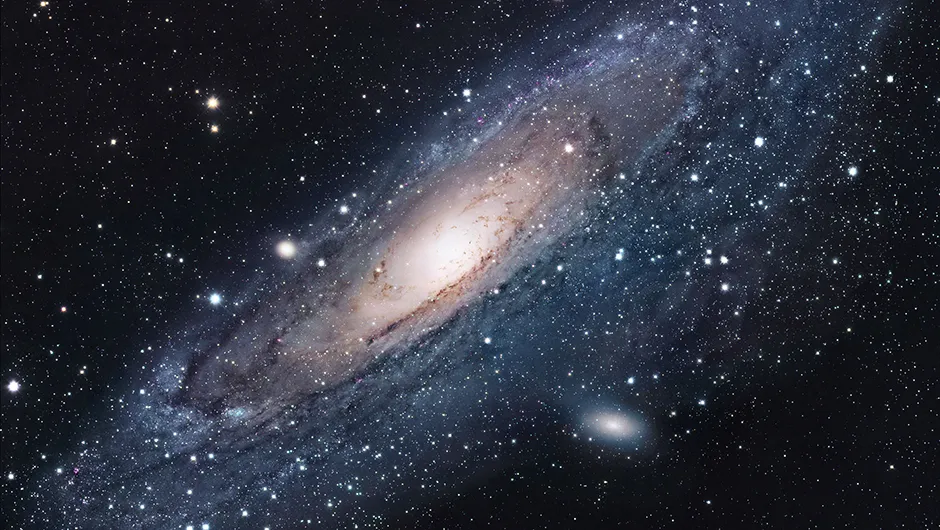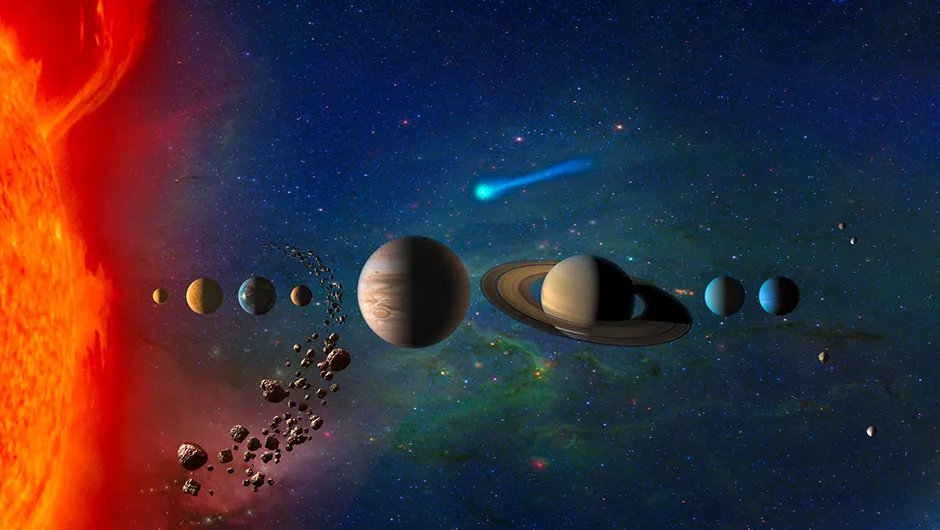Star Wars is replete with aliens. They include Arkanians, Jawas, Blood Carvers and Bouncers, Crokes and Ewoks, Gungans and Hutts, Tusken Raiders, Wookiees and Womp Rats.
All told, there are hundreds of species living on thousands of worlds.
However, the geography of the inhabited part of the Star Wars galaxy poses an interesting comparison with our Milky Way Galaxy.
Galaxies
Consider galaxies.There are more stars in our Universe than there are grains of sand on all of the beaches on planet Earth.
It’s worth pausing for a while to imagine being on one of those beaches, soft golden sand sweeping off into the distance.
Bright sunny day, of course.
In fact, let’s make it the Caribbean.
No expense spared.
You reach down, hands cupped, and gather up two handfuls of the golden sand.
Then you let the sand fall through your fingers, the grains glistening as they catch the sunlight.
Each grain is a star.
And each star is a sun, like our own local star, the Sun.
You saunter on a few more steps, and again you gather up the sand and let it fall. And so on, over all the beaches on Earth. So much sand, so many stars.
A group of researchers at the University of Hawaii actually tried putting a number to the grains of sand on the world’s beaches.
The Earth has roughly (and we’re speaking very roughly here) 7.5 x 1018 grains of sand, or seven quintillion, five hundred quadrillion grains.
And yet, there are ten stars for every one of these sand grains.
That’s also eleven times the number of cups of water in all the Earth’s oceans, and one hundred billion times the number of letters in the fourteen million books in the US Library of Congress.
(These incredible stats are somewhat put into perspective by the fact that the number of stars in the Universe is the same as the number of H2O molecules in just ten drops of water!)
On a large scale, swarms of such stars dwell in galaxies, effortlessly wheeling their way through the vastness of deep space.
Each galaxy contains millions, if not billions, of stars.
Under cover of the night sky, some galaxies can be seen with the naked eye.
It’s worth remembering that the very word “galaxy” derives from the Greek term galaxias, or “milky circle,” for its appearance to the eye.
Imagine yourself again, on our same trip, under the starry reach of the Caribbean sky. You look up, the star field is dazzling.
But here and there is the odd nebulous smudge of a galaxy.
The great galaxy in the constellation Andromeda, for instance, is one of our near neighbors, and yet even this nearby citadel of stars is resolvable into detail only by telescope.
So that’s how galaxies look to the naked eye, like tiny thumbprints in the sky.
Yet, the Milky Way Galaxy holds between two hundred to four hundred billion stars, and has special significance, since it is the home galaxy of planet Earth.

Looking Down on a Galaxy from Above
Now imagine taking a galactic trip in the Millennium Falcon.
Given its legendary reputation for speed on the Kessel Run hyperspace route, the outer reaches of our Milky Way will be like a walk in the park.
The hyperdrive of the Millennium Falcon is engaged and the local starscape blurs as we fly off to the outer limits of our Galaxy.
Once in position, through the window of the Millennium Falcon, the Milky Way is a fabulous, jaw-dropping sight.
Looking down on our Galaxy from above, it looks like a huge, luminous spiral, consisting of around two hundred billion stars, one of which is the Sun.
From one edge to the other, the Milky Way could be as much as 150,000 lightyears across.
Space must be truly huge to house so many stars.
So huge, in fact, that we need this special unit of lightyears with which to measure it.
A lightyear is the distance light travels in 365 Earth days.
Light is the fastest thing known to us.
A beam of light will travel a little over 186,000 miles in one second.
This means light can travel 5,874,601,670,040 miles in a year. It also means that our Milky Way is 881,793,805,977,541,248 miles across!
The Geography of the Star Wars Galaxy
The Star Wars galaxy is around the same size.
It’s divided into regions, with the Deep Core as the central and most luminous region of its space.
The populous Core Worlds are where the human species first evolved.
The Core includes planets such as Alderaan and Coruscant, which were granted permission to settle new planets.
They were followed by the Colonies (which included the planets Castell and Halcyon), the Inner Rim (which housed the world of Onderon), the Expansion Region (housing the likes of Aquaris), the Mid Rim (which included Naboo), and Outer Rim Territories (which included Hoth and Tatooine).
The areas of the Star Wars galaxy were sometimes referred to as the galactic north, south, east, and west.
The Unknown Regions existed to the galactic west, and remained largely unexplored throughout galactic history, as the many trade routes headed outwards towards the galactic east.
Wild Space referred to regions at the very edge of the galaxy, inhabited by sentient species, but never fully charted, explored, and civilized.
Almost all of the inhabited worlds, Tatooine, Naboo, Hoth, and so on, lie in the Expansion Region of the Star Wars galaxy.
Looking down from above, the Expansion Region would sit on the right of our stunning sight. Jakku, Endor, and Coruscant are situated around the galactic core.
If this distribution of inhabited worlds were the same in our Galaxy, then our Sun and its family of planets could be sitting in the Milky Way’s version of the Unknown Regions.
It might even be called the dark side of the Galaxy.

The Fermi Paradox
This situation poses an interesting and possible solution to the question of life elsewhere in our Milky Way.
For generations, if not centuries, astronomers had wondered whether, in a galaxy assumed to be full of alien life, we should by now have seen some evidence.
The question was neatly summed up in the Fermi Paradox: “Where is everybody?”
Enrico Fermi was an Italian physicist who created the world’s first nuclear reactor and received the Nobel Prize for Physics in 1938 for his discovery of transuranium elements.
Fermi’s remark came while he was chatting over lunch with colleagues about the possibility that many sophisticated societies populate our Galaxy.
Most of the scientists thought it safe to assume that we humans have a lot of cosmic company.
However, Fermi’s keen brain realized that if this were true, if there really are a lot of alien civilizations, then some of them would have spread out, as has been assumed since in the case of Star Wars galactic history.
So Fermi understood that any civilization with the necessary rocket technology, and the outward urge of imperial incentive, could swiftly colonize an entire galaxy.
By his calculation, within ten million years, every star system could be brought under the jackboot of the Empire, or a similar tyranny.
Ten million years is not as long as it may sound, compared with the age of our Galaxy, so imperial conquest of the Milky Way should be a relatively rapid affair.
Now, if these alien civilizations have had more than enough time to pepper the Galaxy with their presence, where are they all?
Where are the legions of sleek spaceships tearing across the sky?
Where are the hordes of invading aliens?
Where’s the future promised in sci-fi?
Solutions to the Fermi Paradox
Many researchers have considered the Fermi Paradox a radical conclusion drawn from such a simple observation: if intelligent extraterrestrials exist, humans would surely by now have had some close encounter with them.
Many have offered believable solutions.
Perhaps a potentially expansionist alien civilization would self-destruct before they developed interstellar space travel?
Maybe the stars are so far apart that space travel is simply too tricky and expensive?
Maybe aliens do visit, but keep their visits and observations secret until humans have settled their petty differences?
Star Wars offers another option.
Let’s assume the Sun and Earth lie on the dark side of the Galaxy, in the Milky Way’s version of the Unknown Regions.
This could mean our Solar System is just too far from the fashionable Core Worlds of the Milky Way.
It would take aliens a journey of trillions of miles, either through the dense galactic core or through its spiralled suburbs, to get to the Solar System.
Maybe in the Milky Way, too, there are many trade routes headed outwards towards the galactic east, and in our galactic history the galactic west is inhabited but not yet fully explored and charted.
Maybe we are not alone after all.
This chapter was excerpted with permission from The Science of Star Wars: The Scientific Facts Behind the Force, Space Travel, and More! by Mark Brake and Jon Chase. Copyright 2016, Skyhorse Publishing, Inc.
For more information on the book, visit Skyhorse Publishing's website.
If sci-fi is your thing, read our guide to the best space movies of all time.
